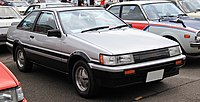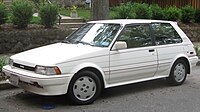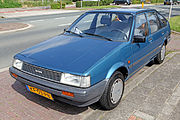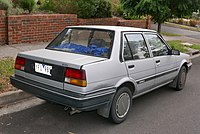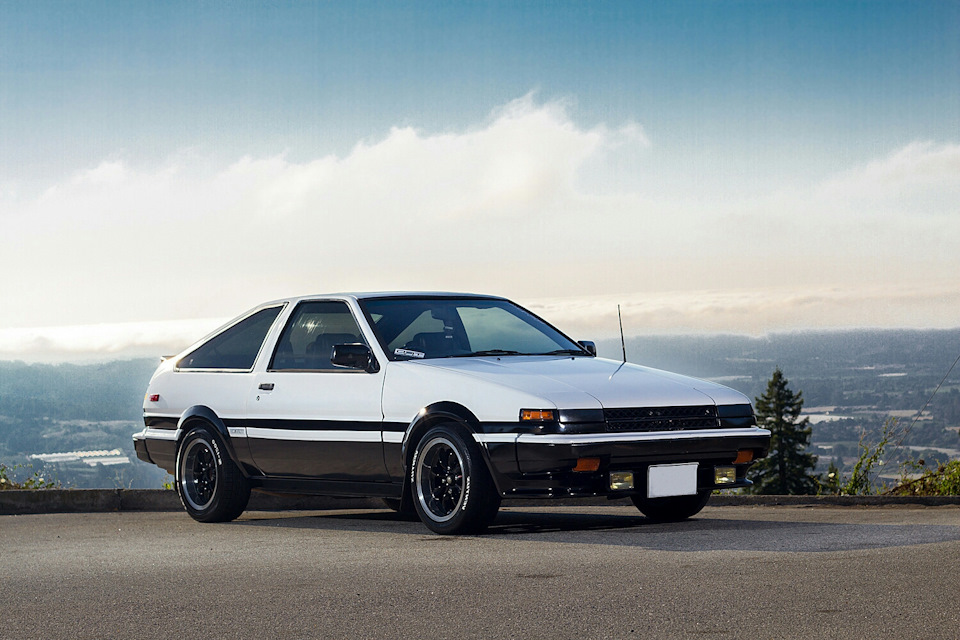
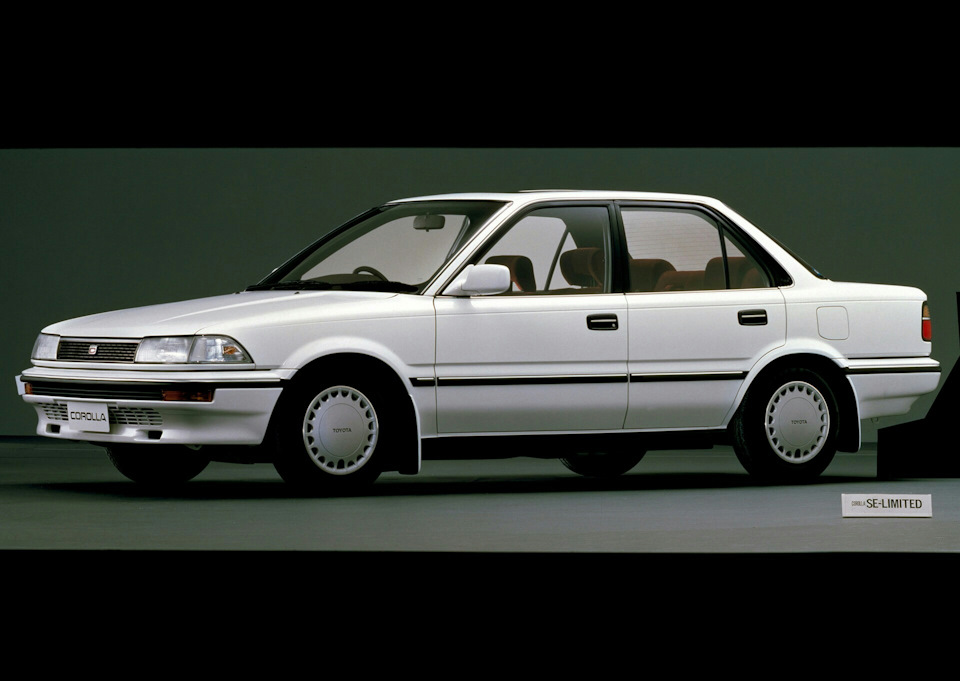
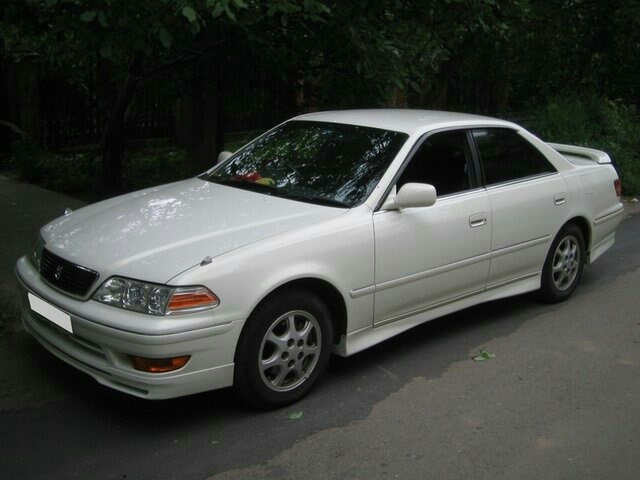
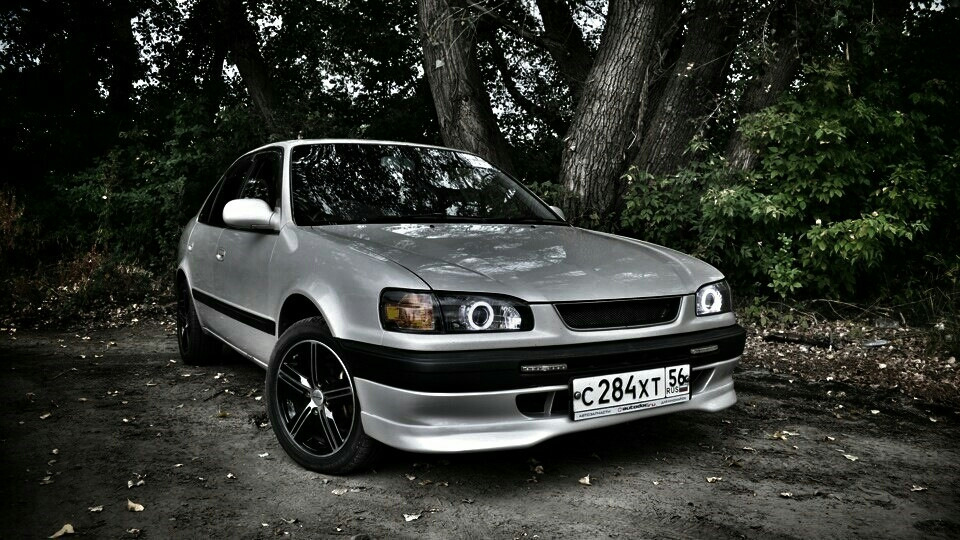
Toyota Sprinter Trueno, Toyota Corolla Levin — компактные купе фирмы Toyota производившиеся на базе автомобилейToyota Corolla\ Toyota Sprinter.
— Сборка в Японии
— Года пр-ва 1983-2000
— Класс купе
— Инные обозначения: AE85…AE111, хачироку, Хачиго, кюни.
— 2 кузова: купе, хэтчбек.
— Компановка: заднеприводная, переднеприводная.
— Двигатели( по ним будет отдельно) : 1,6 L 3A-U, 5A-FE, 4A-FE, 4A-GE, 4A-GZE l4.
— Трансмиссии: 5ступка мкпп, 4ступка акпп
— Масса:923 — 1100 кг
1 поколение:
серия AE85, AE86 — 10 Мая 1983 — 30 Мая 1987AE86, AE85 выпускался в нескольких модификациях: купе и трёхдверный хетчбек, со «слепыми» фарами и обычными. АЕ85 от AE86 в основном отличается двигателем (3A-U — 1.5L, один распредвал и 8 клапанов), КПП (тросиковый выжим сцепления) и задним дифференциалом (без блокировки). AE86 — последняя заднеприводная модификация «Levin» и «Trueno». AE86 имеет под капотом двигатель 4AGE (twin cam). Кроме того, это последняя легкая заднеприводная Toyota, не считая выпускающегося с 1998 года кабриолета Toyota MR-S, имеющего среднемоторную компоновку. Японцы называли АЕ86 «Хачироку» («хачи» и «року» — цифры 8 и 6 по-японски), а АЕ85 «Хачиго».
2 поколение:
серия AE91, AE92 — 6 Июня 1987 — 25 Мая 1991 Вслед за 6-м поколением Corolla и Sprinter, которые были переднеприводными, Corolla Levin тоже получил передний привод. По индексу кузова (AE92) его называли «Кюни» (на японском языке «кю» — это 9, «ни» — 2). Corolla Levin стал несколько легче предыдущего поколения модели; однако существовала модификация GT-Z, оснащенная более мощным двигателем мощностью 165 л.с. с суперчарджером. В 1989 году, в середине жизненного цикла поколения, автомобиль подвергся небольшому рестайлингу, в частности поменялся внешний вид переднего бампера и решетки радиатора.
3 покаление:
серия AE100, AE101 — 16 Июня 1991 — 15 Апреля 1995 В седьмом поколении моделей Corolla и Sprinter, выпущенном в 1991 г., в период экономики «мыльного пузыря», особое внимание уделялось сочетанию эксплуатационных и товарных качеств. Corolla Levin и Sprinter Trueno, по сути, являлись одинаковыми машинами; несмотря на то, что в них сохранился имидж прежних поколений, эти машины стали более «продвинутыми» в спортивном направлении. В Sprinter Trueno перестали использоваться «складывающиеся» (прячущиеся) фары, вместо них использовались более узкие, что, в свою очередь, позволило отказаться от решетки радиатора в передней части кузова.
Несмотря на то, что вес обеих машин приближался к 1 тонне, что не характерно для спортивных машин, спортивность достигалась использованием подвески Super Strut Suspension и более мощными двигателями: 170-сильным с приводным нагнетателем (4A-GZE) и 160-сильным 20-клапанным с системой изменения фаз ГРМ VVT (модификация мотора 4A-GE, известная под именем Silver Top). В 1993 году Corolla Levin подвергся некоторым изменениям (в частности, изменился бампер) и упрощениям, что позволило снизить её стоимость.
4 поколение:
серия AE110, AE111 — Май 1995 — Июль 2000 4 поколение Toyota Corolla Levin и Sprinter Trueno, выпущенное в 1995 году, имело более угловатый дизайн — в полном соответствии с изменениями, произошедшими в дизайне всех автомобилей Toyota в середине 90-х. Однако общая концепция была унаследована от предыдущих поколений модели. Так же, как и ранее, отличие Corolla Levin от Sprinter Trueno заключалось в разном дизайне передней и задней оптики и наличии/отсутствии решетки радиатора.
Как и предыдущее поколение, Corolla Levin выпускалось только в кузове купе. Наибольшие изменения коснулись двигателей: на топовых модификациях BZ-R, BZ-V, BZ-G стоял всё тот же, но несколько модифицированный (расходомер воздуха был заменен на датчик абсолютного давления (MAP), диаметр дроссельных заслонок увеличился с 42мм до 45мм и, также был увеличен диаметр выпускных окон, подъём кулачков впускного распредвала был увеличен с 7.9мм до 8.2мм), атмосферный 20-клапанник 4A-GE объёмом 1,6 л с системой VVT, мощностью 165 л.с. и крутящий момент 162/5600 н-м/об.мин при степени сжатия 11.00 (известный как Blacktop или «Черноголовый», прозванный так, из-за окрашенной в черный цвет клапанной крышки двигателя). Кроме того, на Corolla Levin устанавливались 100-сильный двигатель объёмом 1,5 литра (комплектация FZ) и 1,6-литровый 4A-FE — мощностью 115 л.с. (модификация XZ). Ходовая часть практически не изменилась, однако благодаря некоторым технологическим изменениям разработчикам удалось добиться снижения веса автомобиля в целом.
Опционально ставили вместо передней подвески типа «Макферсон» многорычажную подвеску «Super Strut Suspension», позволяющую добиться более острого управления автомобилем. Так же ставился опционально люк, ключ с дистанционным управлением и более качественная музыкальная система.
В 1997 году произошли небольшие дизайнерские изменения облика автомобиля, в частности, стал использоваться бампер с круглыми противотуманными фарами, а на версию BZ-R стали устанавливать шестиступенчатую механическую коробку передач. Также был незначительно изменен двигатель 4A-FE, после 1997 года его мощность составила 110 л.с. На этом поколении история автомобиля Corolla Levin закончилась.
На каждое поколение Levin/Trueno в том числе ставился двигатель 4A-GE в разных модификациях.

From Wikipedia, the free encyclopedia
| Toyota Corolla (E80) | |
|---|---|
 |
|
| Overview | |
| Manufacturer | Toyota |
| Also called | Corolla Levin/Sprinter Trueno AE85/86 Toyota Corolla Sprinter Chevrolet Nova (North America) |
| Production | 1983–1987 February 1985 – December 1988 (Australia)[1] 1986-1990 (Venezuela)[2] (AE82 Sedan) |
| Assembly | Toyota City, Japan Fremont, California (FX) (NUMMI) North Jakarta, Indonesia Shah Alam, Malaysia Parañaque, Philippines (DMC) Samut Prakan, Thailand Cumana, Sucre, Venezuela[2] Durban, South Africa Thames, New Zealand Port Melbourne, Victoria, Australia |
| Designer | Fumio Agetsuma (1979) |
| Body and chassis | |
| Body style | 3/5-door hatchback (FX) 4-door sedan 4-door sedan (six-window) 5-door liftback 2-door coupé (RWD) 3-door hatchback coupé (RWD) |
| Layout | Front-engine, front-wheel-drive / rear-wheel-drive |
| Powertrain | |
| Engine |
|
| Transmission | 4/5-speed manual 3/4-speed automatic |
| Dimensions | |
| Wheelbase | 2,430 mm (95.7 in) 2,400 mm (94.5 in) (AE85/86) |
| Length | 4,135 mm (162.8 in) FX: 3,970 mm (156.3 in) North America: 4,254 mm (167.5 in) FX: 4,064 mm (160.0 in) |
| Width | 1,635 mm (64.4 in) |
| Height | 1,328 mm (52.3 in) FX: 1,346 mm (53.0 in) FX16: 1,341 mm (52.8 in) |
| Curb weight | 840–940 kg (1,852–2,072 lb) |
| Chronology | |
| Predecessor | Corolla E70 |
| Successor | Corolla E90 |
The Toyota Corolla E80 is a range of small automobiles manufactured and marketed by Toyota from 1983 to 1987 as the fifth generation of cars under the Corolla and Toyota Sprinter nameplates, with production totaling approximately 3.3 million, and most models adopting a front-wheel drive layout.
The AE85 and AE86 Corolla Levin and Sprinter Trueno (SR-5/GT-S in US) retained rear-wheel drive from the previous E70 generation,[3][4][5] along with the three-door «liftback» (E72), three-door van (E70) and five-door wagon (E70) of the previous generation, which remained in production. The AE86 ultimately gained international prominence in the motorsport of drifting and wide popularity in Showroom Stock, Group A, and Group N, Rally and Club racing.
In a joint venture with General Motors, mildly restyled versions of the front-wheel drive AE82 sedan and liftback were locally manufactured and sold in the United States as the Chevrolet Nova.
Design[edit]
The front-wheel-drive wheelbase was now 2,430 mm (95.7 in).
It was the first Corolla to top the New Zealand top-ten lists, ending Ford’s dominance of that market. A shorter hatchback range, called the Corolla FX in Japan and the Corolla Compact in Germany, arrived in October 1984 on the front-wheel-drive platform.[6] The three- and five-door hatchbacks resembled the Corolla sedan with a truncated rear deck and trunk. Although there was a five-door liftback model of the basic Corolla, the shorter FX hatchback was sold alongside it. The Corolla FX replaced the Toyota Starlet in North America.
A DOHC 16-valve engine, designated 4A-GE, was added in 1983 on the rear-drive cars. It was a 1.6 L (1,587 cc) inline-four and produced 124 PS (91 kW), turning the Levin/Trueno (Japan), Corolla GT coupé (Europe) and Corolla GT-S (North America) into a what was arguably a sports car.[7] The three-door FWD hatchback was also available with this engine; it was known as the Corolla FX-GT in Japan and Corolla FX-16 in North America. This engine was also combined with the front-drive transaxle to power the mid-engined Toyota MR2.
The Sprinter sports cars, in two-door coupé and three-door liftback forms, were notable for being the line’s first use of pop-up headlamps, which the equivalent Corolla Levin sports models did not have. The liftback has a drag coefficient of Cd=0.34.
Launched in Japan in May 1983, it reached Europe (including the right-hand drive UK market) three months later, and sold well in most European markets. The car was facelifted in May 1985, receiving larger headlights akin to those installed on the coupés. The smaller 1.3-litre A-series engine was replaced by the new 12-valve 2E unit at the same time for most markets.
Japan[edit]
The 1.3-litre 2A engine was replaced by the more modern 12-valve 2E engine along with a May 1985 facelift at Toyota Corolla Store locations. The range began with the 1300 Custom DX and ended with the 1600 GT Limited, introduced in June 1986.[8] The FX hatchback lineup was considered a semi-separate line and received a different nose and different equipment levels than its sedan and liftback counterparts. The 1.3 was not available in the FX, targeted at sportier buyers, until the 2E engine became available.[6]
Japanese market engines:
- 2A-LU – 1.3 L I4, 8-valve SOHC, carb, 75 PS (55 kW) (AE80)
- 2E-LU – 1.3 L (1,295 cc) I4, 12-valve SOHC, carb (EE80)
- 3A-LU – 1.5 L (1452 cc) I4, 8-valve SOHC, carb, transverse mount, 83 PS (61 kW) (AE81)
- 3A-U – 1.5 L (1452 cc) I4, 8-valve SOHC, carb, 83 PS (61 kW) (AE85, RWD)
- 4A-ELU – 1.6 L (1587 cc) I4, 8-valve SOHC, EFI, 100 PS (74 kW) (AE82)
- 4A-GELU – 1.6 L (1587 cc) I4, 16-valve DOHC, EFI, 130 PS (96 kW) (AE82)
- 4A-GEU – 1.6 L (1587 cc) I4, 16-valve DOHC, EFI, 130 PS (96 kW) (AE86, RWD)
- 1C-L – 1.8 L (1,839 cc) I4, diesel, Mechanical Injection (CE80)
Japanese market chassis:
- AE80 – FWD, 2A-LU engine, 4-door sedan (Custom DX, DX, GL, GL Saloon, Lime, SE), 5-door liftback (SX)
- AE81 – FWD, 3A-LU engine, 4-door sedan (DX, GL, GL Saloon, Lime, SE, SE Saloon), 5-door liftback (SX, ZX), 3-door hatchback (FX-D, FX-L, FX-L Lime), 5-door hatchback (FX-G, FX-L, FX-Lime, FX-SR)
- AE82 – FWD, 4A-ELU/GELU engine, 4-door sedan (GT, SR), 5-door liftback (SX, ZX), 3-door hatchback (FX-GT, FX-SR), 5-door hatchback (FX-SR)
- AE85 – RWD, 3A-U engine, 2-door coupé (Levin Lime, Levin GL, Levin SE), 3-door liftback (Levin SR)
- AE86 – RWD, 4A-GEU engine, 2-door coupé (Levin GT, Levin GT-APEX), 3-door liftback (Levin GT, Levin GT-APEX, Levin GTV)
- CE80 – FWD, 1C-L engine, 4-door sedan (DX, GL, GL Saloon, SE), 5-door liftback (SX), 3/5-door hatchback (FX-G, FX-L)
- EE80 – FWD, 2E-LU engine, 4-door sedan (DX, GL, SE, SE Saloon), 5-door liftback (SX), 3/5-door hatchback (FX-D, FX-L)
-
Toyota Corolla Levin 2-door coupé GT-APEX (AE86)
-
Toyota Corolla Levin GT 2-door coupé (AE86)
-
Toyota Corolla Levin GT-APEX 3-door liftback (AE86)
-
Toyota Corolla GT 4-door sedan (AE82)
-
Toyota Corolla GT 4-door sedan (AE82)
-
Toyota Corolla FX-GT 3-door hatchback (AE82)
North America[edit]
The American specification was available with either SOHC or DOHC engines. From 1985 to 1988, NUMMI in Fremont, California built a rebadged version of the Sprinter sedan sold by Chevrolet as the Chevrolet Nova. During calendar 1985, Corolla sedans and Sprinter-type 5-door hatchbacks (sold under both Nova and Corolla nameplates) were added, with the Toyota-branded US built cars gradually superseding imports from Japan and Nova hatchbacks being offered from the 1986 model year. The Corolla FX, including the sporty FX16 model, were also built in California.[9]
While all the rear-wheel drive 80-series Corollas were AE86 chassis in North America, the VINs differentiated between the three equipment levels: the DX got AE85, the SR-5 got AE86, and the GT-S received an AE88 VIN.
North American market engines:
- 1C 1.8 L I4, diesel, mechanical injection, 58 hp (43 kW) (1984–85)[10]
- 4A-C 1.6 L I4, 8-valve SOHC, carb, 71–75 hp (53–56 kW)
- 4A-GEC 1.6 L I4, 16-valve DOHC, EFI, 112 hp (84 kW) in rear-wheel drive applications, 108 hp (81 kW) in the FX16[9]
North American market chassis:
- AE82 – FWD sedan 4-door, 5-door hatchback (Std, LE, LE Ltd, SR-5, GT-S) 3-door hatchback (FX/FX16)
- AE86 – RWD coupé 2-door, 3-door liftback coupé
-
- DX with 4A-C has «AE85» in VIN
- SR-5 with 4A-C has «AE86» in VIN
- GT-S with 4A-GEC has «AE88» in VIN
- CE80 – FWD sedan 4-door (low sales numbers)
-
1984 Toyota Corolla DX Liftback (US)
-
1986–1987 Corolla AE82 sedan (US)
-
1986–1987 Corolla Sport SR5 hatchback (US)
-
1987–1988 Corolla FX16 GT-S hatchback (US)
-
1987–1988 Corolla FX16 GT-S hatchback (US)
-
1987-1988 Corolla AE82 FX hatchback (US)
Europe[edit]
European market engines:
- 2A 1.3 L I4, 8-valve SOHC, carb, 69 hp (51 kW)
- 4A 1.6 L I4, 8-valve SOHC, carb, 84 PS (62 kW)
- 4A-LC 1.6 L I4, 8-valve SOHC, carb, 78 PS (57 kW) (desmogged version for Sweden and Switzerland)[11]
- 4A-GE 1.6 L I4, 16-valve DOHC, EFI, 116–124 PS (85–91 kW) (121 PS in the hatchback)
- 1C 1.8 L I4, Diesel, Mechanical Injection, 58 PS (43 kW)
- 2E 1.3 L I4, 12-valve SOHC, carb, 75 PS (55 kW)
European market chassis:
- AE80/EE80 – FWD 4-door sedan, 5-door liftback, 3/5-door hatchback (2A, 2E engines)
- AE82 – FWD 4-door sedan, 5-door liftback, 3/5-door hatchback (4A engine)
- AE86 – RWD 2-door coupé, 3-door hatchback coupé (4A engine)
- CE80 – FWD 1.8 diesel 4-door sedan, 5-door liftback, 5-door hatchback (1C engine)
-
1986 Corolla (AE82) 5-door hatchback (Sweden)
-
1985–1987 Corolla (EE80) XL hatchback (the Netherlands)
-
1983 Corolla (AE86) 3-door liftback (UK)
-
1986 Corolla (EE80) 1.3 DX sedan (Portugal)
-
1983 Toyota Corolla (AE80) 1.3 GL 5-door liftback (the Netherlands)
Australia[edit]
Australian market engines:
- 2A-LC 1.3 L I4, 8-valve SOHC, carb, AE80
- 4A-LC 1.6 L I4, 8-valve SOHC, carb, AE82 78 hp (58 kW)
- 4A-C 1.6 L I4, 8-valve SOHC, carb, AE86 78 hp (58 kW)
- 4A-GELC 1.6 L I4, 16-valve DOHC, EFI, 115 hp (86 kW) AE82 Twin Cam 16
Australian market chassis:
- AE80 – FWD 4-door sedan /5-door hatchback 2A-LC
- AE82 – FWD 4-door sedan /5-door hatchback /5-door Seca Liftback 4A-LC and 4A-GELC (Twin Cam 16 only)
- AE86 – RWD 3-door hatchback (badged as Toyota Sprinter) 4A-C
Australian market levels:
- ‘S’ This was the most basic version of the E80 corolla. It came with only a driver’s side door mirror, Corolla emblem where the analogue clock or tachometer would be, basic AM/FM radio, 4 speed manual or 3 speed automatic. AE80 hatch and sedan, AE82 hatch and sedan.
- ‘CS’ This was a more mid-level version with the inclusion of door pockets, 5 speed manual, an analogue clock in the combination meter, passenger-side door mirror and wheel covers. AE80 hatch and sedan, AE82 hatch, sedan and sēca liftback.
- ‘CS-X’ this was considered high range. They had included a tachometer in the combination meter, digital VFD clock in the dashboard, alloy rims, more seat adjustments, 4 speakers, and both door mirrors being remote controlled. AE82 sedan, hatch and sēca liftback.
- ‘Twin Cam 16’ This was the highest level. Different interior with a 3 spoke leather steering wheel and leather gear knob similar to the ones used in FX corollas and AE86s, alloy rims, fuel injected 4A-GELC engine, 5 speed manual transmission only, combination meter with tachometer, digital clock in dashboard. Hatch and sēca liftback only.
-
1985 Toyota Corolla (AE82) CS-X hatchback (Australia)
-
1985 Toyota Corolla (AE82) CS-X hatchback (Australia)
-
1987 Toyota Corolla (AE82) CS sedan (Australia)
-
1987 Toyota Corolla (AE82) CS sedan (Australia)
-
1987 Toyota Corolla (AE82) CS Seca liftback (Australia)
-
1987 Toyota Corolla (AE82) CS Seca liftback (Australia)
Asia[edit]
Mainly 1.3 and 1.6 petrol engines were available in Asia:
- 2A-C 1.3 L I4, 8-valve SOHC, carb,
- 2E-L 1.3 L I4, 12-valve SOHC, carb, 72 PS (53 kW) SAE net (Indonesia)[12]
- 4A-C 1.6 L I4, 8-valve SOHC, carb
After the 1985 facelift, the 1.3 was switched to the new 12-valve E-series unit. Model designations changed at the same time; in Indonesia it was switched from GL to SE Saloon. The newer model has slightly bigger headlamps and also received flush hubcaps.
Asian market chassis:
- EE80 – FWD 4-door sedan
- AE80 – FWD 4-door sedan
- AE82 – FWD 4-door sedan
-
1983-1985 Toyota Corolla 1.3 GL (Indonesia)
-
1985-1987 Toyota Corolla 1.3 SE Saloon (Indonesia)
-
1983-1985 Toyota Corolla 1.6 GL (Malaysia)
Motorsport[edit]
The rear-wheel-drive AE86 models campaigned in the Group A rally championship from 1985 until 1992. Victories included a class win in the 1985 Rally Portugal (its first), with Jorge Ortigão driving and J. Batista navigating.[13] The car continued to be raced as late as the 1993 Acropolis Rally, with its best finish a third overall in the 1989 Rallye Côte d’Ivoire (with Adolphe Choteau/Jean-Pierre Claverie).[14]
The AE86 became international prominent in the motorsport of drifting. Owners may heavily modify their AE86 models to where the only connection to the original model is the bodyshape.[15]
John Smith won the 1986 Australian 2.0 Litre Touring Car Championship driving a Corolla GT AE86.[16]
References[edit]
- 別冊CG: 自動車アーカイヴ 80年代の日本 [Car Graphic: Car Archives Vol. 11, ’80s Japanese Cars] (in Japanese). Tokyo: Nigensha. 2007. ISBN 978-4-544-91018-6.
- ^ «Overview of Overseas Production Affiliates: Oceania». Toyota Motor Corporation. 2012. Retrieved 11 July 2014.
- ^ a b «Historia de Corolla» (in Spanish). Toyota de Venezuela. Retrieved 23 July 2014.
- ^ Lye, Gerard (14 January 2020). «TAS 2020: Toyota 86 Black Limited Concept and AE86 Sprinter Trueno GT-Apex Black Limited on display». paultan.org. Malaysia. Retrieved 17 January 2020.
- ^ «Oh what a feeling!». carsales. Australia. 3 November 2020. Retrieved 17 January 2020.
- ^ Hsu, Dan (8 June 2011). «EVENTS: 2011 Toyotafest Part 06». Japanese Nostalgic Car. US. Retrieved 17 January 2020./
- ^ a b Car Graphic: ’80s Car Archives, p. 21
- ^ De Leener, Philippe (15 December 1983). «Toyota Corolla GT: une véritable GT» [a true GT]. Le Moniteur de l’Automobile (in French). Brussels, Belgium: Editions Auto-Magazine. 34 (784): 46.
- ^ Car Graphic: ’80s Car Archives, p. 19
- ^ a b Assenza, Tony (September 1986). «Tested: 1987 Toyota Corolla FX16 Begs to Be Redlined». Car and Driver.
- ^ «Fuel Economy of 1984 Toyota Corolla». fueleconomy.gov. (US). Retrieved 29 February 2012.
- ^ Büschi, Hans-Ulrich, ed. (6 March 1986). Automobil Revue 1986 (in German and French). Vol. 81. Berne, Switzerland: Hallwag AG. ISBN 3-444-00450-8.
- ^ Toyota Corolla (brochure) (in Indonesian), Jakarta, Indonesia: P.T. Toyota-Astra Motor, 1986, p. 8
- ^ Bridier, Gérard (April 1985). «Walter retourne en enfer…» [Walter returns to hell]. Echappement (in French). Paris, France: Michael Hommell (198): 158.
- ^ «Toyota Corolla (AE86) Profile». Rallye-Info.com. Retrieved 14 September 2014.
- ^ «7 Epic AE86 drift car builds to blow your mind». Drifted.com. 28 November 2016. Retrieved 1 February 2018.
- ^ «1986 Under 2 Litre Australian Touring Car Championship». touringcarracing.net. Australia. Retrieved 3 October 2016.
Материал подготовлен при поддержке сайта Motor1.com
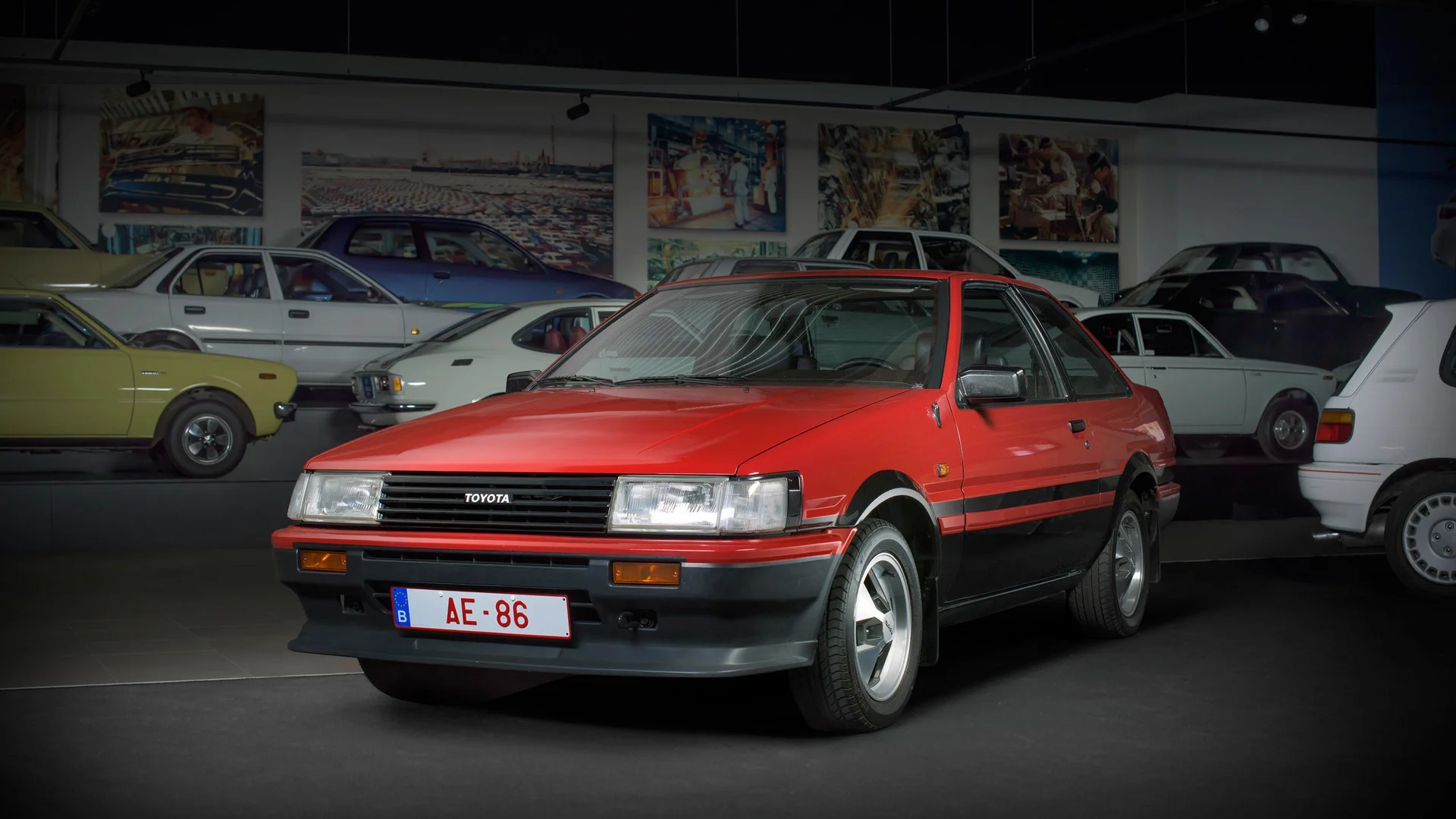
Японский автопром породил на свет массу культовых автомобилей — от «Годзиллы» Nissan GT-R до мегапопулярного «Кукурузера» (и оба они считаются достойными звания рыночных долгожителей). Но один из самых серьезных переворотов в мировом автомобильном сознании устроил автомобиль, который для этого, скажем прямо, вовсе не предназначался.
Две дешевых угловатых машинки — Toyota Corolla Levin и Toyota Sprinter Trueno, отличавшиеся только конструкцией фар, должны были просто стать альтернативным предложением для тех японцев, кому осточертела обычная «Королла».
Но у конструкторов Toyota неожиданно получилось устроить революцию, последствия которой мы с вами можем воочию наблюдать до сих пор. И «Левин», и «Труэно» с кодом AE86 оказались удивительно зажигательными для своего бюджетного статуса. Они получились очень легкими — менее тонны «полетного веса», имели старомодный привод на заднюю ось и потрясающе сбалансированную подвеску, и оснащались поистине шедевральным (учитывая, сколько иен тогда за него просили) двигателем. При объеме в 1,6 л этот атмосферник развивал внушительные 130 л. с. в стоковом варианте и был весьма неприхотлив. Кроме того, у мотора AE86 была еще одна черта характера, за которую японские уличные гонщики через какое-то время начали его просто обожать: он удивительно легко смирялся с разнокалиберными доработками.
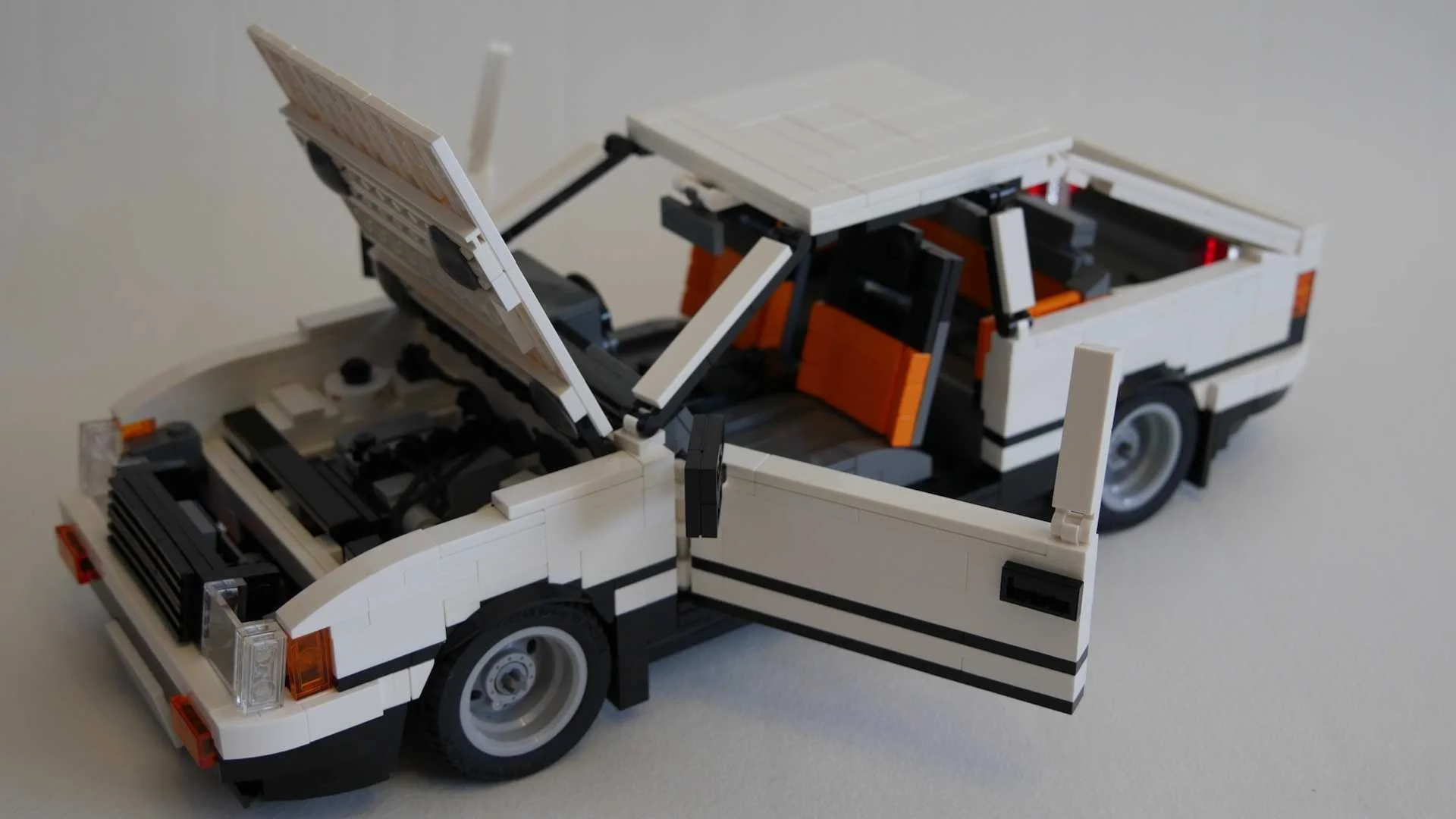
Впрочем, главным фактором популярности «хачироку» (это «восемь» и «шесть» по-японски) стали цена и время появления на свет. Toyota AE86 вышла на рынок в начале восьмидесятых, в период, когда в стране Восходящего солнца вовсю набирали обороты гонки тогэ — нелегальные заезды по извилистым горным дорогам, которых в Японии предостаточно.
И «восемь шесть» стала настоящим подарком для рейсерской бедноты, у которой не было денег ни на «скайлайны», ни на роторные «Мазды». Восхитительно дешевая на их фоне коробочка становилась в руках умелого гонщика серьезным оружием — и японские горы пали под натиском «хачироку».
Именно с бумом популярности AE86 связывают и начало победного шествия по планете такого явления, как дрифт. А по мнению авторов сверхпопулярной и чертовски долгоживущей манги Initial D, в зарождении дрифта виноваты ежедневные попытки довезти груз тофу до места назначения без повреждений именно на стареньком «хачироку».
По легенде, доставщик творога хотел сделать свою работу не только быстро, но и максимально аккуратно, и поэтому старался не тормозить перед поворотами, плавно проходя их в управляемом заносе — чем впоследствии и обеспечил себе титул «дори кин», то есть, «Король дрифта». По сути, история главного героя Initial D повторяет историю самой Toyota AE86: из грязи, что называется, в князи.
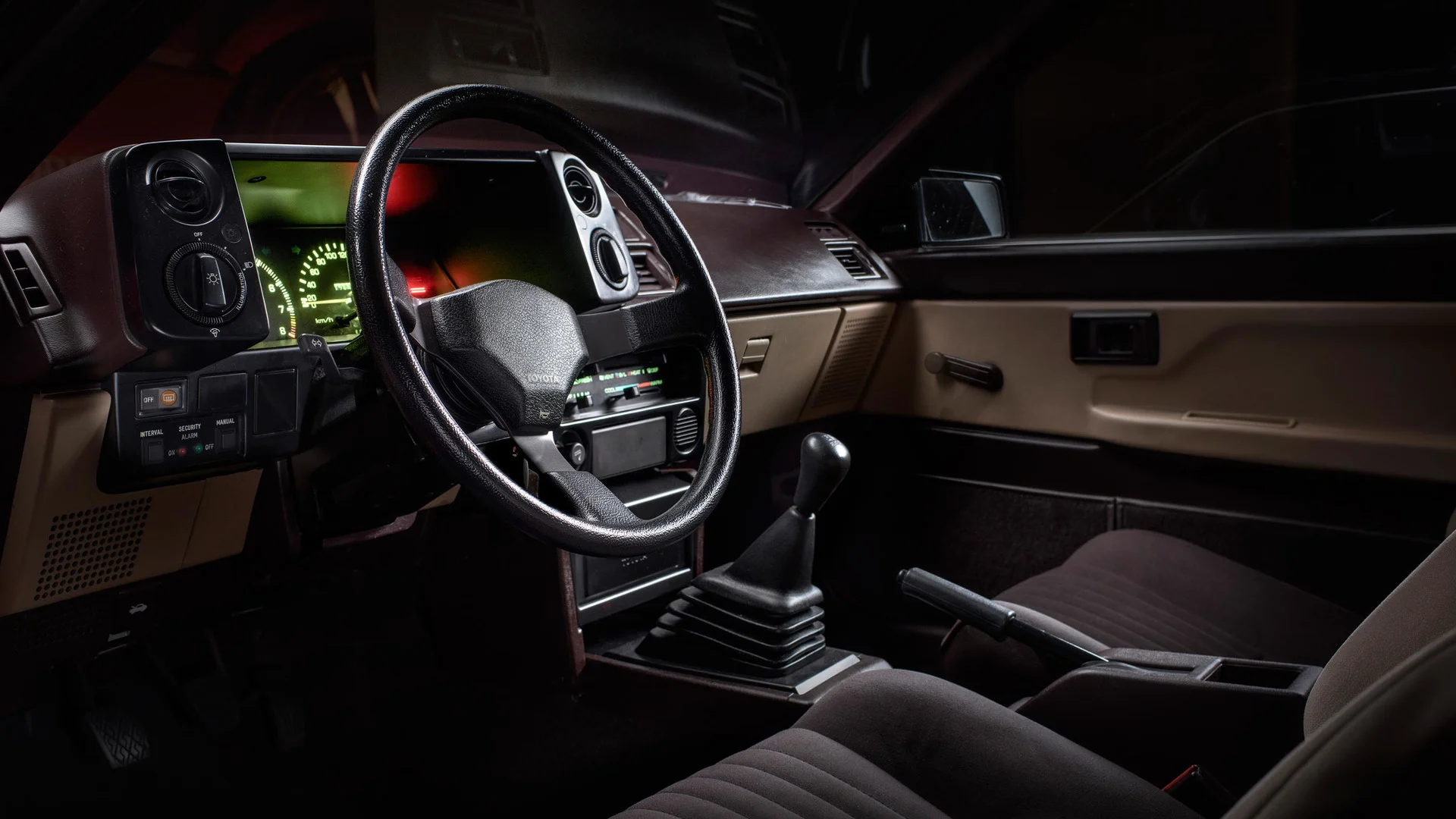
На самом деле, техника вождения в силовом скольжении применялась гонщиками примерно за полвека до этого. Но в чем создатели Initial D, безусловно, правы, так это в том, что дрифт как самостоятельная дисциплина оформился именно на серпантинах Нагано и Осаки.
И логика здесь предельно проста: чтобы движение стало массовым, у его потенциальных участников должна появиться возможность влиться в это движение с минимальными затратами. Вот такой входной билет по предельно доступной цене и обеспечивала Toyota AE86. И с какого-то момента тысячи молодых японцев ночами занимались претворением в жизнь слов знаменитого немецкого спортсмена Вальтера Рерля: «У действительно хороших водителей мухи должны разбиваться о боковые стекла».
Немало хорошего сделал для возведения Toyota AE86 на своеобразный пьедестал и реальный «дори кин» Кеичи Цучия, настоящий идол японского дрифта. Достаточно сказать, что именно благодаря ему в Японии появилась первая легализованная гоночная серия для любителей езды в управляемом заносе — и только после этого ее аналоги возникли в США, Европе и России. А Цучия не только называл «хачироку» своим любимым автомобилем, но и активно его эксплуатировал, добившись на скромной AE86 многих титулов.
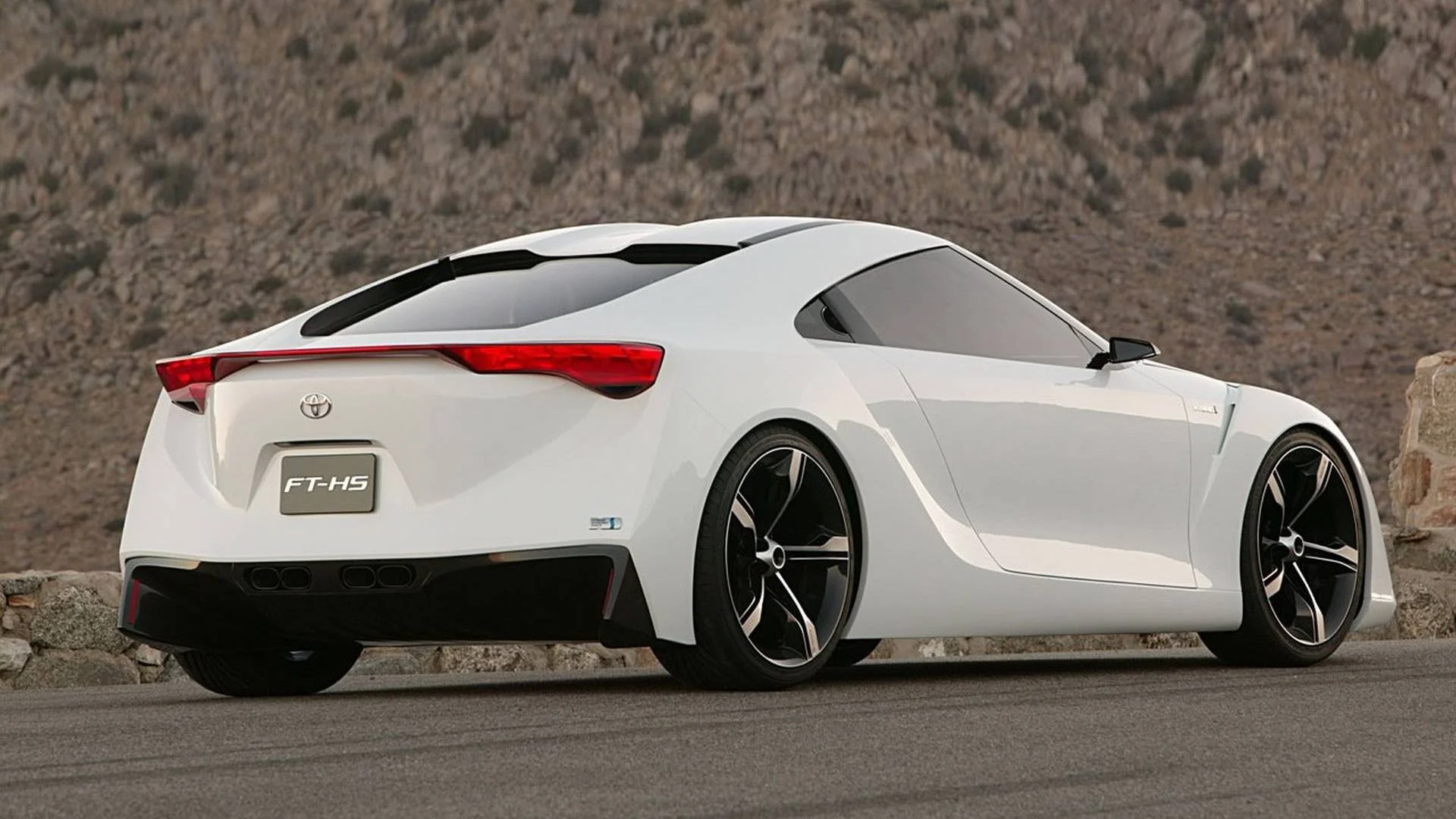
Популярность «хачироку» со временем отнюдь не тускнеет: за хорошо сохранившиеся (или хорошо подготовленные) экземпляры просят вполне осязаемые деньги, тем более, что их не так уж много и осталось. Благодаря культовому статусу Toyota AE86 застолбила себе место и в массовой культуре: на ее счету не только манга из 48 томов и аниме-сериал, но и последовавшая за ними серия одноименных видеоигр, и участие в целом ряде других масштабных игровых проектов, от Need For Speed до Forza Motorsport, Gran Turismo и GTA.
Своего рода данью уважения можно считать и эпизодическое появление «хачироку» в самом известном фильме про дрифт — третьей части «Форсажа». К слову, в небольшом камео там отметился и «дори кин» Цучия. Помните ехидного пожилого рыбака? У знаменитого японца это не первый опыт: в свое время он участвовал и в создании Initial D.
Сама Toyota тоже не забыла про культовый хэтчбек, относительно недавно пополнив свою модельную линейку спорткаром с почти таким же именем GT86 и аналогичной концепцией. На своего прародителя современный «хачироку» походит очень слабо (возможно, потому, что построен вместе с Subaru), но в предшествовавших выходу GT86 концептах некоторые все же умудряются найти сходство с оригиналом. Как бы там ни было, жаль, что продолжения у проекта, скорее всего, не будет.
Больше по теме «Авто»

|
|
| Toyota AE86 | |
|---|---|
| Toyota | |
| aka | Sprinter, Trueno, Levin, 86, Hachi-Roku, Panda-Car |
| Production | 1983 — 1987 360,000+ units produced |
| Class | Compact Sports Car/Hot Hatch |
| Body Style | 2 door notchback coupe 3 door hatchback coupe SR5 (carberuated) GTS (DOHC Injected) 5 seats |
| Length | 165.5 in |
| Width | 64.0 in |
| Height | 52.6 in |
| Wheelbase | 94.5 in |
| Weight | 1950 LB to 2075 LB |
| Transmission | 4 Speed auto (1.6L SOHC) 5 speed manual (1.6 SOHC and DOHC) + drive |
| Engine | 1.5L 3A-U I4 1.6L 4A-C I4 1.6L 4A-GE I4 |
| Power | 112 hp @ 6500 rpm for 1.6 DOHC 85(?) HP for SR5 models for US market. World Market was 128HP for the 4A-GE GT-S / Apex model N/A lb-ft of torque @ N/A rpm |
| Similar | Toyota 86, Subaru BRZ, ’85-’88 Chevy Nova, Geo Prizm |
| Designer | Nobuaki Katayama |
Overview[]
The Toyota Corolla AE86 was a 2-door compact sports car manufactured by Toyota between 1983 and 1987, marketed as the sportiest offering within the wider fifth-generation E80 Toyota Corolla range. It was popularised by its success in various classes of motorsport (e.g. Group A and N of the World Rally Championship, the British Touring Car Championship, as well as numerous forms of Club Racing and Formula Drift), but also for its role in Initial D, a Japanese manga and later anime and live action film, where it was the car driven by the protagonist Takumi, a tofu delivery driver.
Recent Changes[]
The Rear Wheel Drive versions of the Toyota Corolla ended with this model in 1987, and was replaced by the AE92 FWD Corolla in 1988. Both the SR5 and the 4A-GE GT-S model were continued with the new model / body style, but were FWD cars. The Corolla Coupe was dropped from Toyota’s model lineup beginning with the AE101 version. It inspired the later Toyota 86 (designed and manufactured jointly by Toyota and Subaru) which appeared under various guises between 2012 and 2020, as well as the subsequent Toyota GR86 and second generation Subaru BRZ, who’s production is scheduled to commence for the final quarter of the 2021 model year.
Styles and Major Options[]
The Toyota Corolla AE86 came in two different body styles; the SR5 model that was served with the 1.6L carbeurated 4A-C engine and the GT-S (or Apex) model supplied with a 4A-GE 1.6L double overhead cam engine. Both cars were available as a two-door notchback coupe similar to the one pictured in this article, or as a three-door hatchback coupe. The SR5 was available with an electronically controlled 4 speed automatic or 5 speed manual transmission, while the 4A-GE GT-S was only available with a 5 speed manual transmission. An interesting design aspect of this car was that the weight distribution was 50/50 F/R which made it an extremely well-handling and capable car, the GT-S model balanced so as not to induce Lift-off throttle oversteer.
The SR5 was a standard model Toyota with a mostly vinyl interior and standard cloth seats, while the GT-S had a six-way adjustable driver’s seat similar in design to the seat in the Supra, and both front seats were trimmed in leather with cloth inserts in the centre. The GT-S also came with Carbon-fibre look trim in the front door rear seating area panels.
Main differences between the body construction was added bracing in the GT-S, with tubular steel mounted behind the dashboard to further stiffen the car. While suspension design was similar, the GT-S model was equipped with a more aggressive linear spring in the front, a linear spring design in the rear, and more substantial gas pressure shock absorbers at all four corners. The GT-S could also be ordered with a Limited Slip differential.
Pricing[]
Add more fields as necessary.
| MODEL Trims | |||
|---|---|---|---|
| Trim1 | Trim2 | Trim3 | Trim4 |
| MSRP | |||
| $Price1 | $Price2 | $Price3 | $Price4 |
| Invoice | |||
| $Price1 | $Price2 | $Price3 | $Price4 |
Gas Mileage[]
EPA estimates for this car were 21 MPG City and 31 MPG Highway. Real-world mileage figures indicated 33-36 MPG combined driving.
As seen on the FuelEconomy.gov website, the City/Highway MPG averages are as follows:
| Trim | |||
|---|---|---|---|
| Trim1 | Trim2 | Trim3 | Trim4 |
| MPG | |||
| c/h | c/h | c/h | c/h |
Engine[]
Specifications, details, graphs, pictures and other information regarding the powertrain is placed in this section.
4AGE 1587cc
Performance[]
Please make sure to write information of the vehicle’s performance in a third-person point of view. This section should include information about the car’s acceleration figures, handling, braking, etc.
If using information gathered from Road Test articles from a reputable automotive source, then please make sure to cite the quote.
Reliability[]
Warranty options and scheduled maintainence information should be mentioned here.
Safety[]
This section should reference points on safety ratings and features of the vehicle.
Photos[]
Silver Levin
Add Photos of the vehicle here.
Please make sure not to use copyrighted photos.
Colors[]
White, Red, Silver, and Black (Limited Edition).
Main Competitors[]
Create links to other <MAKE> <MODEL> pages in this section.
Unique Attributes[]
The AE86 was famed for its ability to execute easily controllable drifts, even at low speed. This was due to its low, balanced weight, and skinny tires from factory, as well as the option of a limited slip differential. It was, and remains popular for racing and drifting on Japan’s Touge mountain roads.
Interior[]
This section should include information on the interior’s design, build quality, ergonomics, space (head and legroom, front and rear), features, stowage compartments and overall comfortability and livability. Add pictures wherever applicable and keep information in a third-person point of view.
Resale Values[]
Add more fields as necessary.
| <MODEL> Year | |||
|---|---|---|---|
| Year X | Year X-2 | Year X-3 | Year X-4 |
| Resale Value | |||
| $ | $ | $ | $ |
Criticisms[]
Professional drifters in Japan claims that this car has a very good potential in drifting.This car has popular reputation for its drift ability in drifter community.
Generations[]
Fill in as many as appropriate. Add more if necessary and pictures wherever applicable.
Please make sure NOT to use copyrighted pictures.
Current Generation: (YYYY–present)[]
Fifth generation (YYYY–YYYY)[]
Fourth generation (YYYY–YYYY)[]
Third generation (YYYY–YYYY)[]
Second generation (YYYY–YYYY)[]
First Generation/Origins (YYYY–YYYY)[]
Worldwide[]
Design quirks and oddities[]
The amazing drifting ability is what makes this car so unique.This car is also being used by Japanese drifters.The AE86 was featured in a Japanese drifting anime and manga, Initial D.
Awards[]
List out notable awards that the model has recieved while in production. Boldface the company or organization that gives out the award, and Italicize the name of the award.
See Also[]

|
|||
| TOYOTA | |||
|
Toyota Motor Corporation Toyota | Lexus | Scion | Hino | Daihatsu Current Cars: Allion · Aurion · Auris · Avalon · Avensis · Aygo · bB · Belta · Blade · Brevis · Caldina · Camry · Camry Hybrid · Camry Solara · Century · Corolla · Crown · Ist · Matrix · Mark II Blit · iQ · Mark X · Passo · Porte · Premio · Prius · Pregrés · Ractis · Reiz · Vios · Vitz · Yaris · Urban Cruiser · Sai · Etios · GT 86 Vans/SUVs: 4Runner · Alphard · Avanza · Estima · Fortuner · FJ Cruiser · Harrier · Hiace · Highlander · Highlander Hybrid · Hilux Surf · Hilux SW4 · Innova · Ipsum · Isis · Kluger · Land Cruiser · Land Cruiser Prado · Liteace · Mega Cruiser · Noah · RAV4 · Rush · Sequoia · Sienna · Sienta · Tarago · Vanguard · Venza · Voxy · Wish · Mark X ZiO 1 · Corolla Rumion · Verso Trucks: Dyna · Hilux · QuickDelivery · Tacoma · Tundra Historic Cars: 2000 GT · AE86 · Altezza · Aristo · Carina · Celica · Celsior · Corona · Cressida · Echo · MR2 · MR-S · Paseo · RAV4 EV · Soarer · Starlet · Supra · Tercel · Vienta · Vista · Windom · WiLL Cypha · WiLL Vi · WiLL VS · MR2 · Chaser · Mark 2 Vans/SUVs: FJ40 · FJ70 · Previa · MasterAce / Van / Tarago / Model F · Tamaraw / Kijang · Revo Trucks: T100 · Stout One-Off Special Century Royal Racing Vehicles Corolla G5 · Celica LB Turbo · Dome Celica Turbo · 7 · Celica C · TS010 · GT-One · TS030 Hybrid · TF101 · TF102 · TF103 · TF104 · TF105 · TF106 · TF107 · TF108 · TF109 · TF110 · Celica WRC · Corolla WRC · Corolla Group A Rally Car · Corolla Group S Rally Car · 4Runner Baja 1000 · 82C · 83C · 84C · 85C · 86C · 87C · 88C-V · 89C-V · 90C-V · 91C-V · 92C-V · 93C-V · 94C-V · MR2 Group S Rally Car · Celica Twincam Turbo Rally Car · HF89 Eagle Concept Vehicles FT-HS · Hybrid X · PM · Endo · FTX · FSC · iQ Concept · FT-MV Concept · i-REAL Concept · Hi-CT Concept · RiN Concept · 1/X Concept · Crown Hybrid Concept · Biomobile Concept · A-BAT Concept · TRD Hilux Concept · Tundra Ducati Desmosedici Transporter Concept · TRD Tundra Street Concept · TRD Tacoma X-Runner Concept · Tacoma V8 Incross Concept · TRD Tundra Double Cab Off-Road Concept · Tacoma Truck Retro Concept · Tundra TR Concept · CNG Camry Hybrid Concept · Lemans Racer Concept · FT-EV Concept · RV-2 Concept · HC-CV Concept · Auris HSD Full Hybrid Concept · Prius Plug-in Hybrid Concept · FT-86 Concept · FT-EV II Electric Vehicle Concept · Surfrider Camry Hybrid CNG Concept · Billabong Ultimate Venza Concept · Tundra Hot Rod Concept · Alessandro Volta · Tacoma TX Package Concept · TRD Camry TS01 Concept · X-Runner Concept · Sportivo Concept · Dedicated Hybrid Concept · FT-CH Concept · FT-86 G Sports Turbo Concept · Prius G Sports Concept · iQ Disco Concept · NORI Concept · Prius C&A Concept · Prius c Concept TRD · Modellista · Engines · Transmissions · G-Book |
|||
| edit | Sakichi Toyoda | Corporate website | A division of the Toyota Motor Corporation |
External Links[]
Please include any external sites that were used in collaborating this data, including manufacturer sites, in this section.
The Toyota Corolla AE86 is a true Japanese classic, and its prices are jumping as if they were on a trampoline. These models are very rare and highly valued. It’s a pleasure to look at cars like this; it’s a pleasure to touch them and listen to the stories of how they were brought back to life. But I like to drive. So we headed out to a rally with the grey Toyota Corolla AE86.
Just try to imagine what thoughts were going through my head when, in the second corner of the first special stage, my wheels locked up and I skidded off the course through grass as high as the roof until we finally ran into the tyres at a very low speed.
We slid pretty far, so I had time to remember all of the swear words I know, to think about all of the different consequences, and to apologise to Aleksas, my co-driver who also happens to be the owner of this car. Once I had filled the entire sport seat with adrenalin, my co-driver calmly got out and began pushing the car. Nankang NS-2R semi-slicks aren’t very good on asphalt, and they’re hopeless on grass. It took us a good minute. We buried our thoughts of victory and calmly finished that special stage.
I couldn’t concentrate on driving because I spent the whole time thinking about what happened to the car, whether I had broken something or if everything was fine. At the stop point, we saw that nothing terrible had happened: the front bumper lip had been knocked off a bit, and the car itself had a few minor battle scars. I had to tone down my driving style for the next two days, since the car has just been pulled out of the garage after a long rehab and wasn’t yet totally back on its feet.
That was Press Rally 2018, an international race for journalists. Aleksas and I were participating for the fifth time. Always with a Toyota, and so far – always in the 1.6 class. This is full of low-displacement cars of very similar capacity, which results in an extremely close and fierce battle.

Toyota Corolla AE86 in Press Rally 2018

Toyota Corolla AE86 in Press Rally 2018
Through Hardship to the Stars
Aleksandras “Aleksas” Dainys is a professional rally co-driver and race car driver whose entire life revolves around racing. He likes cars, he likes classic cars, and he has fallen in love with Toyota’s models. For as long as I’ve known him, I’ve known that he has dreamed about this small, rear-wheel-drive hatchback called the Corolla AE86.
And it’s a smart choice. This is a really fun car to take out on the weekend, and since it’s a Toyota, it won’t give you any headaches in terms of reliability. Plus it will have some major residual value that will only grow. The problem is that well-maintained models are already going for prices that are out of this world, so Aleksas, just like a lot of other car enthusiasts who like to design, took the project route. Only who would have thought that almost three years would pass from when the legend showed up in his garage to when it got out on the streets?

Restoration of Toyota Corolla AE86

Restoration of Toyota Corolla AE86
“Their prices really are high and they’re only going up. It’s a big investment. But somehow I found a body of this model in France for a very reasonable price, so I thought why not put it together. After all, Lithuania is the land of ‘golden hands’, and I’m surrounded by people who can repair anything. I bought it and the car arrived in Lithuania, but the body wasn’t in the best shape. We dismantled it and I took it to be sanded. They sanded it and there was just nothing left of the body. It was that rotted.
Then there were two roads: sell everything that I’d bought, or suck it up and look for another one so that I could make one out of two.
I sold half of all the parts I had bought. Not because I had given up my dream, but just so I could have some working capital. I remembered an ad for a car in Denmark that I had found when I still had the first body. But the ad was already gone. Almighty Google helped me dig it out of the inactive ad archive – I found his email address and we started writing. It turns out he hadn’t sold that car. He had changed his mind. I told him my story and he agreed to sell it. The next day, I already had a plane ticket to Denmark. This time I didn’t buy it sight unseen – I went to see the car myself, and it was definitely not in bad condition. It was a race-ready model with roll bars that had once driven in the Danish rally championship. But since all the rallies there are on asphalt, the body wasn’t damaged. And the old man was only selling the car because he couldn’t drive it any more due to health problems. The car was in Kaunas on St John’s Eve 2017,” says Aleksas about how this beauty was purchased.
The very next day, this Toyota Corolla AE86 was out for a spin on the Nemuno Žiedas motor racing circuit in Kačerginė. The new owner drove it hard and wore it out to see how much life the car still had in it. After all, it was a 1983 model, which is retirement age for cars.

Restoration of Toyota Corolla AE86

Restoration of Toyota Corolla AE86
Fell in Love with Every Detail
“I just wanted to make a car for myself. But not the kind that would stand under a glass dome for me to look at – I wanted one that I could enjoy driving,” he said of his approach.
Then the work that took all winter began. Even though the car seemed to be in pretty good shape, it only left the shop this year in the beginning of summer, because the owner had fallen head over heels.

Restoration of Toyota Corolla AE86

Restoration of Toyota Corolla AE86
“It was completed dismantled. All of the problem areas on the body were taken care of. It spent all winter in the paint chamber, and then we started putting it back together.
All of the mechanically tired parts were either refurbished or replaced with new ones. The old radiator was replaced with a larger aluminium radiator. A higher capacity oil cooler was put in. Every detail of the chassis was restored, sanded and painted. I played around with every part. Even when I took apart the front panel, I took every switch home to wash, clean and restore.
If there was an opportunity, I tried to put in higher level parts. They’re still being made for this model. The community of Corolla AE86 fans and owners is very active, so even though the prices are really high, you can find virtually anything. Except for body parts, which are no longer being made. That’s why I didn’t use the cutting and welding method – he problem areas were taken care of with the hardest methods so that the body would be completely original,” said Aleksas of his spring extracurricular activities.

Restoration of Toyota Corolla AE86

Restoration of Toyota Corolla AE86
Ruined It
The only systems he left original, the way he got them, were the engine and the brakes. The Press Rally was this car’s first serious return to racing. Unfortunately, it was without results (we were 4th of the 10 in our class), because these two systems were like a pain a the butt.
Everything was fine with the 1.6-litre engine. You can feel that it’s alive. But the Dellorto carburettors were terrible. That’s right – the carburettors. All Toyota Corollas produced since 1983 have used a direct fuel injection system. But the Danes thought that it would be better with carburettors.
True, in theory, carburettors provide a much higher power and sound effect. But only in theory. Technology from the last century requires meticulous tuning, and most of today’s mechanics have only read about this kind of technology for supplying fuel to the engine in encyclopaedias, and adjustment seems like a task that is just as insurmountable as asking an old lady in the village to work with a computer. The standard engine with direct injection could generate 122 hp. And this one? Nobody knows. Nobody has measured. But based on the speed – no more than 100.
The engine let out a really nice sound – it was practically singing – but that’s it. Beforehand, it had to get in some good spitting. Hitting the gas harder up to 4,000 rpm, it choked, coughed and jerked, and only then did it begin to drive.
The second problem was the brakes. The Dane had improved them, because original Toyota brakes are smaller than on a shopping cart. He improved them using four-piston brake callipers from an old Volvo 240 in front and Fiat 500 Abarth brake discs, and leaving the standard Toyota brake cylinder without the brake booster. The result is that you never know what braking force you’ll get each time you brake. On the first corner, I pressed the brake and the car braked well. On the second corner, I pressed it later and nothing happened, so we got a tour through the fields. On the other special stages, I braked three moments sooner than I would with any other car. So that I’d have time to pump the brakes.
After the Press Rally, the Corolla AE86 went back into the garage. To recover from the latest sores.

Driving Toyota Corolla AE86 is a fantastic experience

Driving Toyota Corolla AE86 is a fantastic experience
A Charge of Positive Emotions
Still, when all the right circumstances came together, it was a fantastic experience. The car handles magically. It’s perfectly balanced. It seems like you don’t even have to drive – all you have to do is think about the manoeuvre, and it does it. When the engine finally gets going, the tachometer goes up almost all the way to the 8,000 mark, and that’s when the engine really sings, playing its song for the entire city. Yes, it is loud.
Nevertheless, Japanese car fans don’t have to worry – this car won’t be going to professional races or anywhere where there’s a risk of damaging it. It’s too rare and expensive of a car. Plus its main purpose is to please the driver. And that is something it does well.

Toyota Corolla AE86 in Press Rally 2018

Aleksas Dainys (left) and Egidijus Babelis in Press Rally 2018
I covered quite a few kilometres behind the wheel myself. It’s not a fast car. But it knows how to create amazing emotions. This Corolla AE86 is a pleasure to drive; it lets you play and wag your tail, and it emits good emotions not only to the owner, but to everyone around.
Not everyone understands what car it is making all that noise, but when they turn around with their angry faces and see an old hatchback, passers-by relax and forgive. It’s not some BMW or Porsche – Toyotas don’t prompt spite or envy; people are behind the driver of this car, and those who understand give you a thumbs up. It’s a car that gives you warm emotions. No aggression, no anger – not even much speed. But it’s still a pleasure.
—
Find your dream car among our Car Categories!

